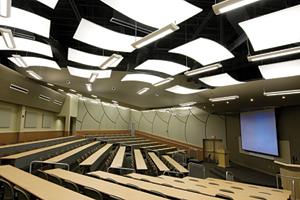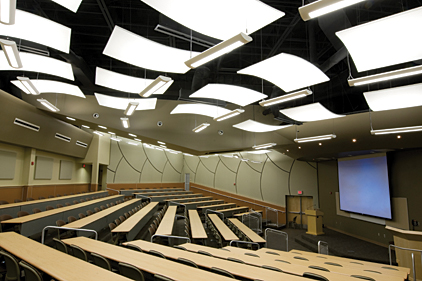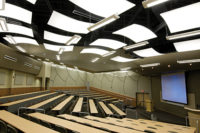Cloud ceilings are being installed increasingly in commercial and industrial buildings. They frequently
function to hide mechanical equipment, improve acoustics or both.

|
| A cloud ceiling in a community college’s lecture hall. Photo credit: ©istockphoto.com/Jesse Kunerth |
Any ceiling system installed in the same plane with horizontal openings to the structure above on all sides is considered a cloud ceiling. Cloud ceilings consist of panels separated by gaps that sit beneath the structural ceiling of a room or space. Panels range in size from discrete ceiling panels with large spaces in between to close-to-full-room-area contiguous coverage with small gaps at the perimeter wall location.
Cloud ceilings provide challenges to sprinkler protection and National Fire Protection Association 13, “Standard for the Installation of Sprinkler Systems,” does not provide specific guidance. The challenges posed by cloud ceilings include allowing heat from the fire plume to pass through the gaps between panels and walls and develop a gas layer at the ceiling. If sprinklers are only installed at the cloud ceiling level, activation will be delayed. On the other hand, sprinklers installed on the structural ceiling may have their spray distribution blocked by the cloud panels.
Obstruction requirements
In most conditions, NFPA 13 requires sprinklers at both the structural ceiling and cloud ceiling panel elevations. However, there are some situations where sprinklers can be located on one level or the other. NFPA Senior Fire Protection Engineer Matt Klaus clarified the requirements in the July/August 2012 NFPA Journal.
Since the situations where sprinklers can be installed on only one level or the other (i.e., on the cloud ceiling level or structural ceiling level) are limited, code changes to NFPA 13 were proposed to allow sprinkler installation only below the cloud ceiling when the gaps between panels are small, which was defined as being an 8-in.
gap or smaller. This measurement was based on modeling done using the Fire Dynamics Simulator, a computational fluid dynamics model developed by the National Institute of Standards and Technology to simulate fire-driven fluid flow. The proposal was rejected, however, due to a lack of validation for the modeling results.
So, in order to gain a better understanding of how cloud ceiling panels affect sprinkler actuation and provide technical basis for sprinkler installation requirements for cloud ceilings, the Fire Protection Research Foundation initiated a project on the topic.
Sprinkler installation
The primary focus of the study is to develop guidance on sprinkler installation requirements for large, contiguous cloud panels with the specific objective of determining the maximum gap distance, both between the wall and panel edge and between panels, at which sprinklers located at the structural ceiling are not effective.
The foundation project involves three tasks. The first is to complete a review of literature and modeling data, relevant previous modeling and model validation studies and a corresponding gap analysis. This task includes the work that was completed and submitted as part of the recent NFPA 13 code change proposals.
The second task of the project is the development of a modeling and evaluation plan, which will be based on the gaps identified in the first task, as well as implementation of the plan, which involves fire-testing of various cloud ceiling panel arrangements and fire sizes. These case studies then will be simulated using the Fire Dynamics Simulator to validate the model for this application and to quantify the relative error.
After validation, the FDS will be used to simulate a series of cloud ceiling scenarios to determine the configurations where sprinklers installed in the structural ceiling would not be effective. The modeling scenarios will include a range of gap sizes, fire growth rates, fire locations (i.e., at the wall, between panels, etc.) and ceiling heights.
Recommendations for appropriate sprinkler installation criteria for cloud ceilings will be developed based on the results from the modeling.
Amanda Kimball is a research project manager at the Fire Protection Research Foundation.


